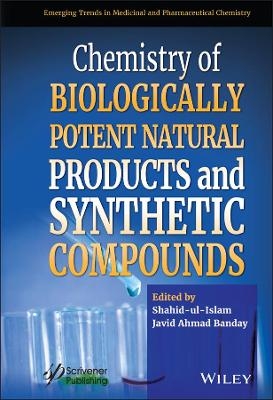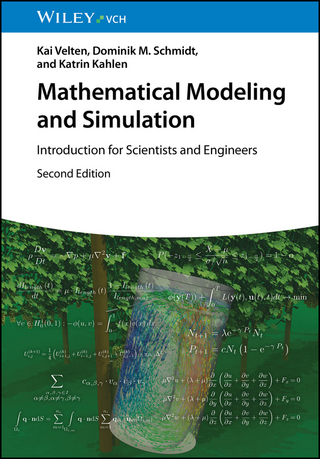
Chemistry of Biologically Potent Natural Products and Synthetic Compounds
Wiley-Scrivener (Verlag)
978-1-119-64034-9 (ISBN)
Several novel natural product derivatives, heterocyclic and other synthetic compounds, have been reported to have shown interesting biological activities including anticancer, antimicrobial, anti-inflammatory, anti-glycemic, anti-allergy and antiviral etc.
Chemistry of Biologically Potent Natural Products and Synthetic Compounds provides up-to-date information on new developments and most recent medicinal applications of the natural products and derivatives, as well as the chemistry and synthesis of heterocyclic and other related compounds.
Shahid-ul-Islam is currently working as Principal Project Scientist at the Indian Institute of Technology Delhi. He worked as DST-SERB National Postdoctoral Fellow at Indian Institute of Technology Delhi, from 2017 to 2019. Then he joined same Institute as Principal Project Scientist where he works on natural products and chemistry of metal based natural dyes using advanced technologies. He has to his credit several research publications, patents and books including several with the Wiley-Scrivener imprint. J. A. Banday is associate professor and head, Department of Chemistry, National Institute of Technology (NIT) Srinagar, J&K, India. Dr. Banday has published a number of research papers in journals of international repute. He has produced and is supervising many M. Phil and Ph.D students. His research areas include isolation, modification & bio-evaluation of natural products, synthetic organic chemistry and medicinal importance of essential oils.
Preface xiii
1 Medicinal Importance of Plant Metabolites 1
Sunita Panchawat and Chetna Ameta
1.1 Introductory Note 1
1.2 Primary and Secondary Metabolites 3
1.3 Functional Roles of Secondary Metabolites 3
1.4 Source and Production of Secondary Metabolites 4
1.5 Classification of Secondary Metabolic Substances 7
1.5.1 Terpenes 8
1.5.2 Phenol-Based Compounds 9
1.5.3 Nitrogen-Containing Secondary Metabolites 10
1.5.3.1 Alkaloids 10
1.5.4 Secondary Metabolites Having Sulfur 11
1.6 Bioactivity of Secondary Metabolites 12
1.6.1 As Antioxidants 12
1.6.2 As Antimicrobials 13
1.6.3 As Anti-Diabetics Agents 13
1.7 Conclusion and Future Perspectives 14
References 14
2 Advances in Natural Products-Based Antiviral Agents 21
Zhipeng Fu, Luis Menéndez-Arias, Xinyong Liu and Peng Zhan
2.1 Introduction 21
2.2 Anti-HIV Agents 22
2.2.1 Terpenes 23
2.2.2 Phenylpropanoids 24
2.2.3 Anthraquinones 25
2.2.4 Alkaloids 26
2.3 Natural Alkaloids With Activity Against HBV and HCV Infections 26
2.4 Anti-Influenza Virus Agents 28
2.5 Natural Products Active Against Herpesviruses 30
2.6 Natural Products Against Chikungunya Virus 31
2.7 Natural Products Targeting Dengue Virus 32
2.8 Natural Products Targeting Coronaviruses 33
2.9 Natural Products Against Other Viral Infections 36
2.10 Conclusion 37
Acknowledgements 37
References 37
3 Bioactive Component of Black Pepper-Piperine: Structure-Activity Relationship and Its Broad-Spectrum Activity—An Overview 43
Arthi Sivashanmugam and Sivan Velmathi
List of Abbreviations 44
3.1 Introduction: What is a Natural Product? 44
3.2 Black Pepper 48
3.2.1 Constituents of Black Pepper 51
3.2.2 Major Alkaloids of Black Pepper 51
3.3 Piperine—Active Molecule of Pepper 52
3.3.1 Isolation of Piperine 52
3.3.2 Piperine as Potential Drug 54
3.3.2.1 Metabolism of Piperine 54
3.3.2.2 Structure-Activity Relationship 55
3.3.2.3 Piperine and Piperine Analogs 59
3.3.2.4 Synergistic Activity of Piperine 72
3.4 Overall Summary and Conclusion 88
References 89
4 Chemoenzymatic Synthesis of Pharmacologically Active Compounds Containing Chiral 1,2-Amino Alcohol Moiety 93
Pankaj Gupta and Neha Mahajan
4.1 Introduction 94
4.1.1 Chirality 94
4.1.2 Biocatalysis 96
4.1.2.1 Biocatalysis is Green and Sustainable 97
4.1.2.2 Industrial Applications of Biocatalysts 98
4.1.3 Vicinal Amino Alcohols 99
4.2 Synthetic Approaches Toward 1,2-Amino Alcohols 102
4.2.1 Chemoenzymatic Synthesis of L-Norephedrine 102
4.2.2 Synthesis of Valinol 106
4.2.3 Chemoenzymatic Synthesis of Atazanavir 107
4.2.4 Chemoenzymatic Synthesis of Levamisole 107
4.2.5 Chemoenzymatic Synthesis of Optically Active (R)- and (S)-Aryloxypropanolamines 108
4.2.6 Chemoenzymatic Preparation of Trans-(1R,2R)-and Cis (1S,2R)-1-Amino-2-Indanol 112
4.2.7 Synthesis of Enantiomerically Pure 2-Aminopentane-1,3-Diol and 2-Amino-1,3,4-Butanetriol (ABT) 113
4.2.8 Synthesis of Optically Active Cytoxazone 115
4.2.9 Chemoenzymatic and Highly Integrated Synthesis of (S)-Tembamide 116
4.2.10 Chemoenzymatic Synthesis of Paclitaxel C13 Side Chain 117
4.3 Conclusion 118
Acknowledgements 119
References 119
5 1,4-Naphthoquinone: A Privileged Structural Framework in Drug Discovery 133
Umar Ali Dar, Mehnaz Kamal and Shakeel A. Shah
5.1 Introduction 133
5.1.1 Overview 134
5.2 Various Targets of 1,4-Naphthoquinone for Its Actions 135
5.2.1 Bacterial Topoisomerase II-DNA Gyrase for Antibacterial Action 135
5.2.2 Mammalian Topoisomerases I and II for Antitumor Action 135
5.2.3 HIV-1 Integrase and Proteinase for or Antiviral Action 135
5.2.4 Dihydroorotate Dehydrogenase for Antimalarial Action 136
5.2.5 Trypanothione and Trypanothione Reductase (TryR) for Leishmanicidal Action 137
5.2.6 Mitochondrial Cytochrome (Coenzyme Q) for Antifungal Action 137
5.3 Antifungal Activity 137
5.4 Antibacterial Activities 140
5.5 Anticancer Activity 142
5.6 Antileishmanial Activity 145
5.7 Antimalarial Activity 147
5.8 Antiviral Activity 149
5.9 Conclusion 149
Acknowledgments 150
References 150
6 Design and Synthesis of Spirobiisoxazoline Derivatives 155
K. Jones Madhuswapnaja, Satyanarayana Yennam and Murthy Chavali
6.1 Introduction 155
6.2 Literature Review on Spiroisoxazolines 157
6.2.1 Chemistry 157
6.2.2 Previous Approaches 159
6.2.3 Biological Importance 163
6.3 Literature Review on Quinones 166
6.3.1 Chemistry 166
6.3.2 Synthetic Approach 167
6.3.3 Biological Importance 169
6.4 Review on 1,3 Dipolar Cycloadditions of Oxime Chloride With Allenoates 171
6.5 Present Work; Spirobiisoxazoline 172
6.5.1 Results and Discussion 172
6.5.1.1 Synthetic Studies 172
6.5.1.2 Spectral Analysis 176
6.5.2 Experimental Section 178
6.6 Conclusion 179
References 179
7 Potential of Metal Complexes for the Treatment of Cancer: Current Update and Future Prospective 183
Shipra Yadav
7.1 Introduction 184
7.2 Conclusion and Future Prospective 195
References 196
8 Design, Synthesis, and Biological Evaluation of Aziridynyl Quinone Derivatives 205
K. Jones Madhuswapnaja, Satyanarayana Yennam and Murthy Chavali
8.1 Introduction 206
8.2 Aziridines 207
8.2.1 Literature Review 207
8.2.2 Synthetic Approach 208
8.2.3 Biological Importance 209
8.3 Quinones 211
8.3.1 Literature Review 211
8.3.2 Synthetic Approach 213
8.3.3 Biological Importance 215
8.4 Aziridinyl Quinone Derivatives 217
8.4.1 Present Work 219
8.4.2 Synthetic Studies 220
8.4.2.1 Confirmation of Regioisomers 63 and 63a 223
8.4.2.2 Confirmation of Regioselectivity for Diaziridinyl Compounds 227
8.4.3 Biological Evaluation 228
8.4.3.1 Antibacterial Activity 229
8.4.3.2 Minimum Bactericidal Concentration 230
8.4.3.3 Biofilm Inhibition Assay 233
8.4.3.4 Antifungal Activity 235
8.4.3.5 Minimum Fungicidal Concentration 237
8.4.3.6 Cytotoxic Activity 237
8.4.4 Experimental Section 241
8.4.4.1 Chemistry 241
8.4.4.2 Biological Studies 243
8.5 Conclusion 246
References 247
9 Exploring the Promising Anticancer and Antimicrobial Potential of Bioactive Triazoles and Their Related Compounds 251
Manzoor Ahmad Malik, Ovas Ahmad Dar, Nitu Singh, Gulshitab Aalam and Athar Adil Hashmi
9.1 Introduction 252
9.2 Anticancer Triazole Derivatives 256
9.3 Antimicrobial Triazole Derivatives 267
9.4 Conclusion 275
References 276
10 Fused Triazolo Isoquinoline Derivatives—Design, Synthesis, and Biological Evaluation 281
K. Jones Madhuswapnaja, Satyanarayana Yennam and Murthy Chavali
10.1 Introduction 282
10.2 Literature Review on 1,2,4 Triazoles 283
10.2.1 Chemistry 283
10.2.2 Synthetic Approach 284
10.2.3 Biological Importance 287
10.3 Review on Isoquinoline and Fused Triazolo Isoquinolines 292
10.4 Present Work 294
10.5 Results and Discussion 294
10.5.1 Synthetic Studies 294
10.5.1.1 Confirmation of Regioisomer 298
10.5.2 Spectral Analysis 299
10.5.2.1 1H NMR Spectral and Mass Analysis 299
10.5.2.2 13C NMR Spectral Analysis 299
10.5.3 Biological Studies 299
10.5.3.1 Antifungal Activity 300
10.5.3.2 Minimum Fungicidal Concentration 300
10.5.3.3 Ergosterol Biosynthesis Inhibition 303
10.5.3.4 Cytotoxic Activity 305
10.5.4 Molecular Docking Studies 305
10.5.5 Experimental Section 309
10.5.5.1 Chemistry 309
10.5.5.2 Biological Studies 311
10.5.6 Molecular Modeling Procedure 314
10.6 Conclusion 314
References 315
11 Amide as a Potential Pharmacophore for Drug Designing of Novel Anticonvulsant Compounds 319
Mehnaz Kamal, Talha Jawaid, Umar Ali Dar and Shakeel A. Shah
11.1 Introduction 320
11.2 Chemistry of Amides 321
11.2.1 Synthesized Methods Utilized for Amide Bond Formation 321
11.2.2 Amide Pharmacophore Containing Anticonvulsant Drug 322
11.2.3 Anticonvulsant Activity 322
11.3 Conclusion 337
Acknowledgments 337
References 337
12 Nitric Oxide, Carbon Monoxide, and Hydrogen Sulfide as Biologically Important Signaling Molecules With the Significance of Their Respective Donors in Ophthalmic Diseases 343
R. C. Maurya and J. M. Mir
12.1 Introduction 344
12.2 A Meaningful Introduction to Gasotransmitters 346
12.3 Biosynthesis and Target of NO, CO, and H2S 347
12.3.1 Biological Synthesis and Target of NO 347
12.3.2 Biological Production and Target of CO 349
12.3.3 Biosynthesis and Target Sites of H2S 353
12.4 Gasotransmitters in the Mission of Vision (Eye-Health Contribution) 357
12.4.1 NO News is Good News for Eyes: NO Donors for the Treatment of Eye Diseases 357
12.4.1.1 Nitric Oxide Releasing Molecules (NORMS) and the IOP 359
12.4.2 Carbon Monoxide, CORMS, and the Ocular System 363
12.4.3 Hydrogen Sulfide and Ophthalmic Diseases 367
12.5 Concluding Remarks and Future Outlook 368
References 368
13 Influence of rol Genes for Enhanced Biosynthesis of Potent Natural Products 379
Erum Dilshad, Huma Noor, Nabgha Nosheen, Syeda Rehab Gilani, Umar Ali and Mubarak Ali Khan
13.1 Introduction 380
13.2 Secondary Metabolites or Natural Products 381
13.2.1 Classes of Natural Products (Secondary Metabolites) 382
13.2.1.1 Terpenoids 382
13.2.1.2 Phenolic Compounds 383
13.2.1.3 Alkaloids 383
13.2.2 Strategies to Enhance Natural Products 383
13.2.2.1 Plant Cell Culture (Somaclonal Variation) 384
13.2.2.2 Genetic Transformation of Plant Cell 384
13.2.2.3 Multiple Gene Transfer Through Improving Vectors 385
13.2.3 Genetic Engineering/Metabolic Engineering 385
13.3 rol Genes 386
13.3.1 Origin of rol Genes 387
13.3.2 Types of rol Genes 388
13.3.2.1 The rolA Gene 388
13.3.2.2 The rolB Gene 389
13.3.2.3 The rolC Gene 390
13.3.2.4 The rolD Gene 391
13.3.3 The Combined Effect of Genes rol on Secondary Metabolism 392
13.4 Mechanism of Action of rol Genes 393
13.4.1 How rol Genes Regulate ROS Production and Mediate Secondary Metabolites Production 393
13.4.1.1 Agrobacterium (rol Gene) and ROS 393
13.4.1.2 Plants Secondary Metabolism and ROS 394
13.4.1.3 Stabilization of Secondary Metabolites Biosynthesis Through rol Genes 395
13.5 Impact of rol Gene on Different Secondary Metabolites 395
13.5.1 Impact of rol Gene on Alkaliods 395
13.5.2 Impact of rol Genes on Flavonoids 396
13.5.3 Impact of rol Genes on Terpenoids 396
13.6 Conclusion 397
References 397
Index 405
| Erscheinungsdatum | 27.07.2021 |
|---|---|
| Reihe/Serie | Emerging Trends in Medicinal and Pharmaceutical Chemistry |
| Sprache | englisch |
| Maße | 10 x 10 mm |
| Gewicht | 454 g |
| Themenwelt | Naturwissenschaften ► Chemie |
| ISBN-10 | 1-119-64034-2 / 1119640342 |
| ISBN-13 | 978-1-119-64034-9 / 9781119640349 |
| Zustand | Neuware |
| Informationen gemäß Produktsicherheitsverordnung (GPSR) | |
| Haben Sie eine Frage zum Produkt? |
aus dem Bereich


